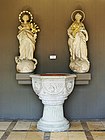Franz Xaver Anton Hauser
Franz Xaver Anton Hauser ("Hauser IV" after Hermann Brommer ; born January 3, 1712 in Schlettstadt in Alsace and François Antoine baptized; † March 23, 1772 in Freiburg im Breisgau ) was a German Rococo sculptor who worked in Breisgau and Alsace . "Anton" was the actual nickname. The usual addition “Xavier” to “Franz” indicates which Saint Francis was meant: Francis Xavier . He himself wrote “Anton Xaver” or just “Xaver”.
Life
Like his father Franz Hauser (1651–1717) he belongs to the great Breisgau sculptor family of the Hauser . After training as a sculptor in Schlettstadt, he was accepted as a journeyman in the Strasbourg guild "zur Steltz" on September 22, 1732 , the guild of goldsmiths and painters. On the same day, Johann Christian Wentzinger was accepted: “Certainly a fateful meeting of the two young sculptors who later worked in Freiburg.” Hauser emigrated to Freiburg, where he was accepted into the building guild “zum Mond” in 1736 and married. The marriage gave birth to four children, one of whom, Franz Anton Xaver (born January 23, 1739), later continued his father's workshop. In 1737 Hauser bought a house in Freiburg's Nussmannstrasse, which he decorated with an Immaculata statue, his first known work, which has now been lost. After the death of his first wife, he married twice more. He and his third wife had nine children, one of whom, Judas Thaddäus, became a sculptor but died at the age of twenty, while two became barrel painters and as such worked with the sculptors Hauser. At times, Hauser carried out sculpture in Freiburg without competition and achieved a preferred position in the city when he was elected guild master. Even so, he did not get rich with his large number of children. On March 23, 1772, according to the Freiburg Cathedral Parish Book of the Dead, “the respectable Mr. Franz Xaver Hauser, guild master and sculptor, gave his creator back his soul”.
plant
Hauser was always in the shadow of Wentzinger and benefited from his artistic inventiveness. When Wentzinger returned to Freiburg from his work at the collegiate church of St. Gallen in 1761 and settled there, the quality of Hauser's work increased. How much he was respected during his lifetime is shown by the number of his commissions; For example, almost all of the work in the Freiburg Cathedral fell to him. So his work has been preserved to a far greater extent than that of his father. These include (in part only ascribed):
St. Sebastian in the left side altar of St. Gallus, Kirchzarten
- the carvings for the high altar in the parish church of Burkheim am Kaiserstuhl , around 1740;
- a larger than life St. Johannes Nepomuk made of red sandstone from the tower of the Freiburg Minster , 1752; Nepomuk replaced a St. Ludwig , who was shot down by a French cannonball in 1744, was killed even after the Second World War by a St. John the Baptist replaced;
- Figures from the Church of St. Cyriak and Perpetua in Freiburg, including a St. Antonius Abbas , who Hauser recreated the Gothic figure of Antonius by Hans Wydyz from the former Antoniterhaus in Freiburg , 1754;
- a very well-preserved stone cross on the outer wall of the sacristy of the parish church Maria in der Zarten (Hinterzarten) , 1757–1760;
- Figures outside and inside in the Catholic parish church of St. Vincentius in March -Neuershausen, 1761–1763;
- the side altars in the Catholic parish church of St. Gallus in Kirchzarten and busts of St. Barbara and St. Ottilie on the high altar, 1763–1765; the other high altar figures were carved by the father Franz Hauser, and a comparison shows how from one generation to the next the style developed from the statuesque, calm structure of the high altar to the sweeping side altars with very moving figures;
- the wooden cover of the baptismal font in the ambulatory of the Freiburg Minster with a depiction of the baptism of Jesus in the Jordan, 1768; The design, like the design for the baptismal font made by Joseph Hörr , comes from Wentzinger;
- also based on Wentzinger's models, the Immaculate and St. Joseph in the Freiburg district of St. Georgen , formerly on the pillars of the entrance to the cemetery, now in the consecration hall, 1770.
Individual evidence
- ↑ a b c Hermann Brommer: The sculptors Hauser in Kirchzarten, Schlettstadt and Freiburg i.Br. (1611-1842). The biographies (part I). In: Journal of the Breisgau history association Schau-ins-Land 89, 1971, pp. 47–93.
- ^ A b Manfred Hermann : The sculptors Hauser in Kirchzarten, Schlettstadt and Freiburg / Br. 1611-1842. The work (part 1). In: Badische Heimat 52, 1972, pp. 2–151.
- ↑ [1] .
- ^ Hermann Brommer: The sculptors Hauser in Kirchzarten, Schlettstadt and Freiburg i.Br. (1611-1842). The biographies (part II). In: Journal of the Breisgau History Association Schau-ins-Land 94/96, 1976/77, pp. 175-200.
- ^ Manfred Hermann and Franz Kern : Parish Church of St. Gallus Kirchzarten. 4th edition. Regensburg, Schnell & Steiner 1999, ISBN 3-7954-4794-1 , S. #.
- ^ Ingeborg Krummer-Schroth: Johann Christian Wenzinger: sculptor, painter, architect, 1710–1797. Freiburg im Breisgau, Schillinger 1987, ISBN 3-89155-058-8 , S. #.
Web links
| personal data | |
|---|---|
| SURNAME | Hauser, Franz Xaver Anton |
| ALTERNATIVE NAMES | Hauser, François Antoine (maiden name) |
| BRIEF DESCRIPTION | German sculptor of the Rococo |
| DATE OF BIRTH | January 3, 1712 |
| PLACE OF BIRTH | Schlettstadt |
| DATE OF DEATH | March 23, 1772 |
| Place of death | Freiburg in Breisgau |




